“I was in a London taxi about five or six years ago,” says Charles Cecil, co-founder of Revolution Software and director of 1996 point-and-click adventure Broken Sword: The Shadow of the Templars. “The driver turned round and asked me what I did, which is of course what taxi drivers do. I told him I write videogames, thinking this would shut him up. ‘Oh yeah?’ he said. ‘Any that I’d know?’ I said, ‘No, you won’t know my games.’ We stopped at a set of traffic lights.
It’s an undeniable classic, but Broken Sword doesn’t make our list of the best PC games to play right now.
“He said, ‘Go on, try me.’ I said ‘Broken Sword?’ He sat there for a moment and said: ‘Are you the bastard that wrote that goat puzzle?’”
That goat puzzle is one of Broken Sword’s defining set pieces and one of the hardest puzzles to ever grace the point-and-click adventure genre. It’s one that, for better or worse, makes the first Broken Sword stand out from its competition – both then and now – and moments like this perfectly exemplify the lasting impression Cecil’s games, not least the adventures of American tourist George Stobbart and ambitious French journalist Nico Collard, have had on generations of players.
Before the partition of Africa, Cecil’s mother was born in British India before moving to Rhodesia, now Zimbabwe. In her adult life, she moved to London in the ’50s, married, and gave birth to Cecil in 1962. Sick of London’s industrial, smog-ravaged conditions, Cecil’s mother convinced her family to move to Africa, thus between the ages of six months and two years old Cecil lived in the Congo.
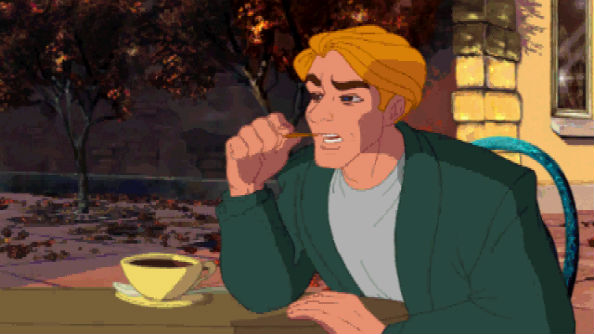
In response to the assassination of Congolese independence visionary Patrice Lumumba – the first democratically elected leader of the Congo – revolution swept the country and Cecil describes he and his family’s time in Africa coming to a “swift conclusion”.
“All the whites on the other side of the Congo were lined up and shot, so we had to get out,” he says. “The only problem was my mother was just about to give birth to my little sister, so it was a very harrowing time and a very harrowing journey.”
It’s a fascinating story and one which might’ve shaped Cecil’s ability to craft such powerful tales in later life – even if he was too young to recall the minutiae of early childhood in The Motherland. Either way, Cecil began writing videogames two decades later when he designed his first titles for the Sinclair ZX81 – Inca Curse and Espionage Island – in 1981. He recalls friends at the time playing Pong, however marks Space Invaders as the first game that piqued his interest and thus prompted him to pursue a career in the field professionally.
By 1990, after working for a variety of publishers and developers in the interim – including Activision, where he managed its European Development Studio – Cecil co-founded Revolution Software. The studio’s first titles, Lure of the Temptress and Beneath a Steel Sky, were a success both critically and commercially and Cecil thereafter set his sights on an Egyptian-themed, hieroglyphic-inspired third project – such had been his desire for a number of years.
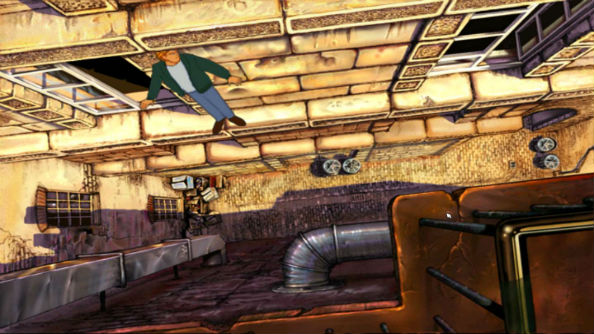
A dinner meeting with publisher Virgin Interactive in London’s King’s Cross followed. Sean Brennan, Virgin’s COO at the time, had backed Revolution’s previous projects wholeheartedly, but after hearing mention of Egypt dismissed the idea on the spot. “Egyptian games don’t sell,” Cecil was told, and that was the end of it.
Later, Brennan mentioned he’d been reading the Italian philosopher Umberto Eco’s novel Foucault’s Pendulum which featured the Knights Templar and as the conversation developed, it became clear this particular group’s rich history could make for an interesting adventure game. At the time, Cecil admits he didn’t know all that much about the subject matter, but it in turn made for very interesting research.
The result was of course Broken Sword. Interestingly, the story sculpted from said research is similar to that of Dan Brown’s 2003 novel The Da Vinci Code – as many a Broken Sword fan has keenly pointed out since. Cecil jokes that while he’d never make a direct accusation, he’s delighted to believe the fans who genuinely think the book – that’d go on to spawn a blockbuster movie starring Tom Hanks – might’ve borrowed from Revolution’s revolutionary point-and-click adventure.
Lighthearted comparisons aside, what makes Cecil’s research quite so important is the attention to detail that’s weaved meticulously throughout his work. While the Knights Templar are the main antagonists in Broken Sword – and Nico and George the heroes – central location Paris itself plays as much of an integral part in relaying the game’s sophisticated and complex narrative to its players. In fastidious preparation, Cecil visited the French capital and in-person on several occasions (it’s a hard life), and had friends translate entire texts on the Templars into English.
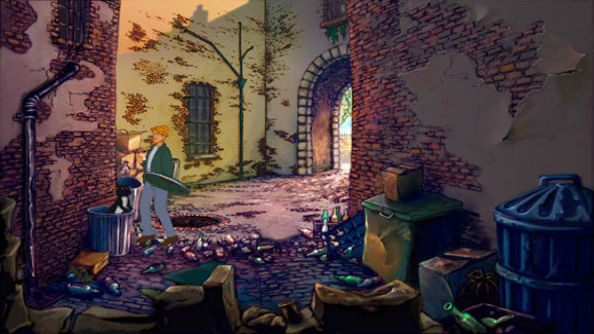
His research became so dedicated that family holidays for years to come became centred on whichever location he wished to interpret next in his games. “Believability is key and is preferable to out and out realism,” says Cecil, but arriving at believable interpretations of landmarks and themes can only be achieved by way of such devotion.
This attitude extends to what makes all point-and-click games tick: puzzles. “If we were doing slapstick puzzles, and it was about ludicrous combinations that you make people laugh over, they would be much, much easier to design,” says Cecil of striking the appropriate difficulty balance when crafting the central tenet of his favoured genre. “We’ve created a rod for our own back in that our puzzles, the way we judge them, make [us ask] do they support the story absolutely?
“Within the context of the story, do they feel logical and believable? Do they fit and do they conform to the expectations of the characters at that particular time and are the characters motivated? What we can do is design these puzzles in our heads, put them on paper, and then have other people read through and check them. Then I’m afraid it’s a very expensive process because we implement them. You do then have a degree of latitude because of course with the voiceover you can direct the player if necessary and can give them hints.
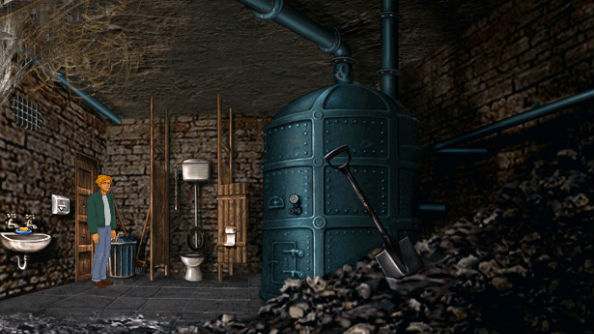
“So, we make the puzzles as hard as we can within the context of the fact that we don’t want them to be contrived and then our balance mechanism is giving our voiceover clues and voices from other characters. Overall, I feel very passionately about them.”
Are you the bastard that wrote that goat puzzle?
The less-than-subtle rant from a random London cabbie echos just how passionately players often feel about Broken Sword’s puzzles. It turns out Cecil is still torn to this day by the cantankerous bovidae tethered to a post in the grounds of the fictitious Lochmarne castle.
“I used to have really conflicting views about the goat puzzle,” admits Cecil. “Because on one hand the reason it’s so hard is that it slightly changes the grammar about a third of the way through. But then it does get noted as one of the, you know, ‘10 most difficult videogame puzzles of all-time’ in places, which is kind of cool.
“The reason that I wrote the puzzle deliberately very hard was that you have two types of people who play adventure games: those that really understood the grammar who moaned like hell that they could play the game much too fast; and then normal people who played it and enjoyed it and it took them the amount of time that we’d expect. Totally naively and totally stupidly, I thought I’d try to pander or appeal to both by putting in a really bastard hard puzzle.
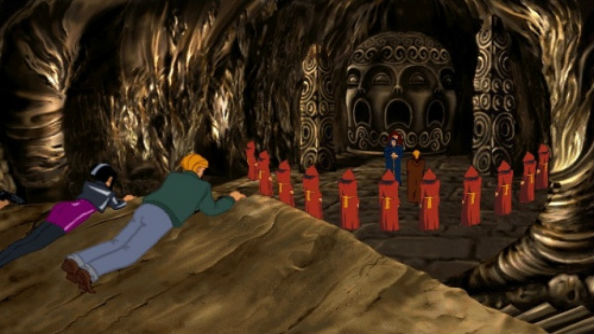
“Of course, that worked quite well for the people who understood the grammar because it stopped them in their tracks for a couple of hours before they moved on. But for the vast majority of people, the silent majority, it absolutely flummoxed them. They had to wait for Q&As to come out and walkthroughs and everything and it was a really unfair puzzle!”
While many would’ve succumbed to the latter, the charm, wit and humour of haphazard patent lawyer-cum-part-time investigator protagonist George Stobbart might just have eased any puzzle-fueled hardship. Beyond the rich detailed environments, devilish challenge and engaging dialogue of Broken Sword lay Georgie’s genuinely laugh-out-loud humour. Although keen to tell a serious story on many levels, Stobart’s buoyant disposition aptly offset the heavier moments of the game – something Cecil suggests was reflective of Revolution’s real life setup at the time.
A lot of Revolution’s earlier work, recalls Cecil, was inspired by a clash of personalities: himself as lead designer and writer, and a writer named Dave Cummings who passed away a number of years ago. Cummings had been a games tester under Cecil at Activision where he wrote beautifully. Cecil remembers a particular test report submitted by Cummings that was so well-written it was better than the adventure he was commenting on itself.
When the European division of Activision folded, Cecil offered Cummings a job. The partnership meant Cecil could focus on the more serious stuff while adding his more obvious sense of humour, while Cummings would utilise his dry, acerbic wit to great effect. Most of Stobart’s character, admits Cecil, came courtesy of Cummings, and while some of his more outlandish suggestions were vetoed, much of the clever, witty lines and innuendo came courtesy of Cummings’ talent.
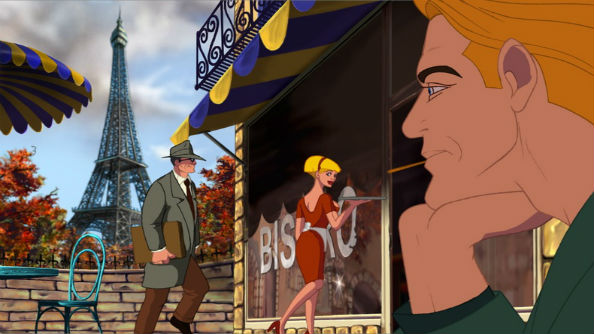
Fast forward 20 years and Broken Sword: The Shadow of the Templars has seen four sequels that’ve made their way onto the vast majority of platforms; with the fifth and latest series entry successfully crowdfunded a few years back. Surprisingly, even after the success of the original – not to mention the support of publisher Virgin’s UK team – a large portion of its US senior management weren’t keen on pursuing a sequel. Had Revolution not owned the IP outright Cecil says “there’s absolutely no question that there wouldn’t have been any more Broken Sword games.”
Luckily more did follow, and the advent of self-publishing towards the end of the ’00s – particularly on Apple devices – pulled Revolution from an otherwise precarious financial position back to being profitable again. They then rode the crowdfunding wave set in motion by Double Fine in 2012 and the rest is history.
In that time, Cecil’s favourite moments at the helm of one of the most renowned British-made videogames of all time have come from fans and their stories – where people have been profoundly affected by Broken Sword and have bonded with it on a level above and beyond the videogame medium itself.
He recalls folk who’ve written to say how inspired they were by Broken Sword’s vibrant Paris that they visited the French capital in real life. He talks of a young boy who’d play Broken Sword at his grandmother’s house and, although she passed away many years ago, the game always reminds him of her.

He mentions a young woman who wrote to him at the end of last year to say she remembers her dad waking her up in the middle of the night with a new game he thought she and her sister would enjoy. “They played it into the night and were devastated when they discovered it was a demo and came to an end.”
It even got to jaded pros: “One of the reviewers at the Official PlayStation Magazine at the time left her job to actually research the Knight’s Templar as she was so fascinated by the subject and the theories behind it.”
And then of course who could forget the outspoken southerner taxi driver?
“Without doubt, the proudest memory are these stories who were enormously moved and inspired and affected by this videogame,” says Cecil. “I would argue that’s more powerful by a film or a book or a television series because it’s an interactive experience, rather than a passive one.”
